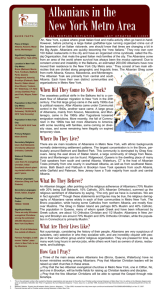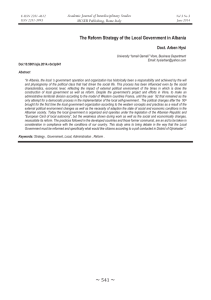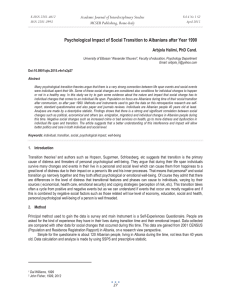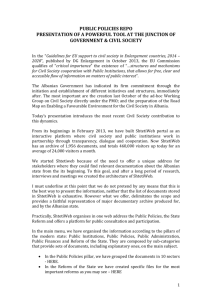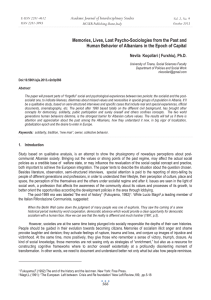The Positioning of the Albanians towards the World Conflict (World... Academic Journal of Interdisciplinary Studies MCSER Publishing, Rome-Italy Dr. Moisi Kamberi
advertisement
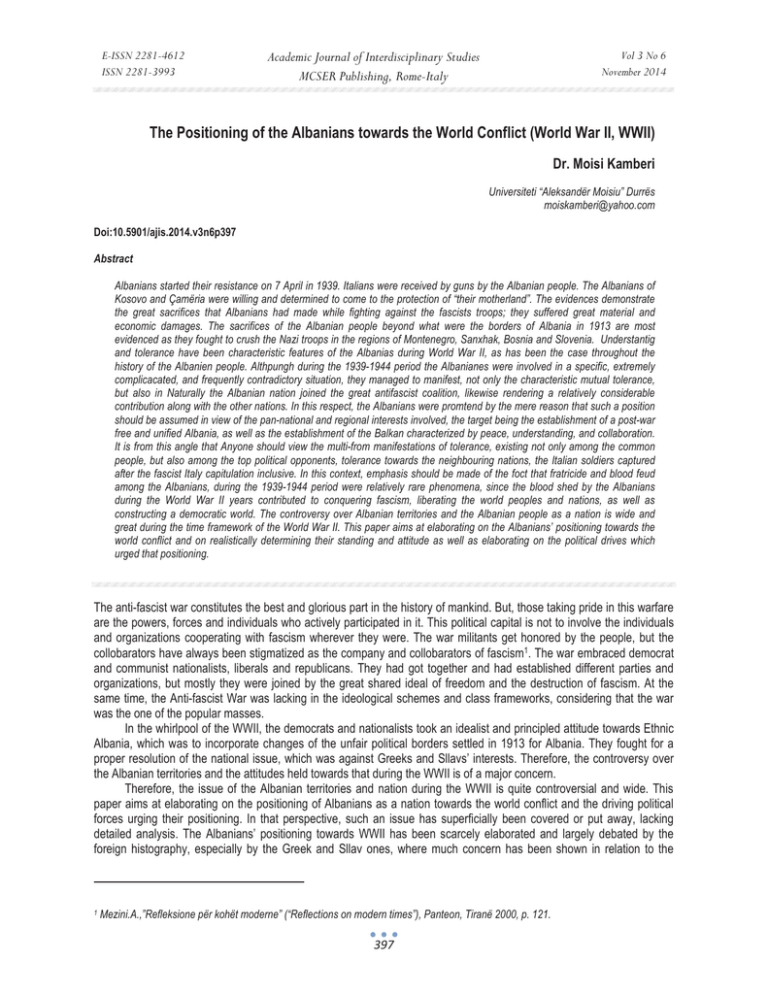
E-ISSN 2281-4612 ISSN 2281-3993 Academic Journal of Interdisciplinary Studies MCSER Publishing, Rome-Italy Vol 3 No 6 November 2014 The Positioning of the Albanians towards the World Conflict (World War II, WWII) Dr. Moisi Kamberi Universiteti “Aleksandër Moisiu” Durrës moiskamberi@yahoo.com Doi:10.5901/ajis.2014.v3n6p397 Abstract Albanians started their resistance on 7 April in 1939. Italians were received by guns by the Albanian people. The Albanians of Kosovo and Çamëria were willing and determined to come to the protection of “their motherland”. The evidences demonstrate the great sacrifices that Albanians had made while fighting against the fascists troops; they suffered great material and economic damages. The sacrifices of the Albanian people beyond what were the borders of Albania in 1913 are most evidenced as they fought to crush the Nazi troops in the regions of Montenegro, Sanxhak, Bosnia and Slovenia. Understantig and tolerance have been characteristic features of the Albanias during World War II, as has been the case throughout the history of the Albanien people. Althpungh during the 1939-1944 period the Albanianes were involved in a specific, extremely complicacated, and frequently contradictory situation, they managed to manifest, not only the characteristic mutual tolerance, but also in Naturally the Albanian nation joined the great antifascist coalition, likewise rendering a relatively considerable contribution along with the other nations. In this respect, the Albanians were promtend by the mere reason that such a position should be assumed in view of the pan-national and regional interests involved, the target being the establishment of a post-war free and unified Albania, as well as the establishment of the Balkan characterized by peace, understanding, and collaboration. It is from this angle that Anyone should view the multi-from manifestations of tolerance, existing not only among the common people, but also among the top political opponents, tolerance towards the neighbouring nations, the Italian soldiers captured after the fascist Italy capitulation inclusive. In this context, emphasis should be made of the foct that fratricide and blood feud among the Albanians, during the 1939-1944 period were relatively rare phenomena, since the blood shed by the Albanians during the World War II years contributed to conquering fascism, liberating the world peoples and nations, as well as constructing a democratic world. The controversy over Albanian territories and the Albanian people as a nation is wide and great during the time framework of the World War II. This paper aims at elaborating on the Albanians’ positioning towards the world conflict and on realistically determining their standing and attitude as well as elaborating on the political drives which urged that positioning. The anti-fascist war constitutes the best and glorious part in the history of mankind. But, those taking pride in this warfare are the powers, forces and individuals who actively participated in it. This political capital is not to involve the individuals and organizations cooperating with fascism wherever they were. The war militants get honored by the people, but the collobarators have always been stigmatized as the company and collobarators of fascism1. The war embraced democrat and communist nationalists, liberals and republicans. They had got together and had established different parties and organizations, but mostly they were joined by the great shared ideal of freedom and the destruction of fascism. At the same time, the Anti-fascist War was lacking in the ideological schemes and class frameworks, considering that the war was the one of the popular masses. In the whirlpool of the WWII, the democrats and nationalists took an idealist and principled attitude towards Ethnic Albania, which was to incorporate changes of the unfair political borders settled in 1913 for Albania. They fought for a proper resolution of the national issue, which was against Greeks and Sllavs’ interests. Therefore, the controversy over the Albanian territories and the attitudes held towards that during the WWII is of a major concern. Therefore, the issue of the Albanian territories and nation during the WWII is quite controversial and wide. This paper aims at elaborating on the positioning of Albanians as a nation towards the world conflict and the driving political forces urging their positioning. In that perspective, such an issue has superficially been covered or put away, lacking detailed analysis. The Albanians’ positioning towards WWII has been scarcely elaborated and largely debated by the foreign histography, especially by the Greek and Sllav ones, where much concern has been shown in relation to the 1 Mezini.A.,”Refleksione për kohët moderne” (“Reflections on modern times”), Panteon, Tiranë 2000, p. 121. 397 E-ISSN 2281-4612 ISSN 2281-3993 Academic Journal of Interdisciplinary Studies MCSER Publishing, Rome-Italy Vol 3 No 6 November 2014 Albanians of Kosova, Çamëria and other territories annexed by former Yogosllavia and Greece. The positioning of the Albanian nation towards the world conflict has not been considered even by the Albanian histography within Albania’s borders and beyond, due to different objective and subjective obstacles. Furthermore, revisions and prejudiced treatment of the question at issue, quite devoid of well-grounded arguments and scientific comittment have been carried out which shamefully reveal potical abusive behaviour driven by the interest of a particular party. This has led to doubts in relation with the “indisputable” conclusions achieved so far by the Albanian and foreign world histography2. Recently, the research and studies on having an objective treatment of the positioning of the Albanians towards the world conflict are thriving. The historical studies confirm that Albania as a nation joined the Great Antifascist Coalition much earlier than other countries, contributing not modestly in line with other powerful nations and that such a positioning and contribution in this war was the only way of rendering it possible for Albanians to resolve the national problems, once the war was over, so that a free, united Albania could be achieved, a notion so intrinsically embedded in history, dating back to the Renaissance time. The positioning of the Albanian nation as a member of the Great Antifascist Coalition, the acknowledgment of the Albanians’ war against fascism since December 1942 provide the answers to many issues, such as: the participating forces and their positioning during the war within and beyond the borders of Albania as settled in 1913, the organization and the leadership of the antifascist war, the different phases of collaboration among the political forces and their tensions, the influence of the international factor during the war, Albanians benefits as a nation once being a member of the alliance, etc. The WWII which ended 68 years ago made the peoples pay an extraordinary price and have dire consequences. It was exactly at the time when it was thought that nothing could be done and that the fascist armies were invincible as their propaganda preached humiliation, that history gave its verdict. Time commanded for the cooperation of all the antifascist forces and countries and the engagement and commitment of all the peoples in an Antifascist War of Liberation. This calling met the support of Albanians since the moment that the Italian and German fascists favored the Francoist Rebellion against the legitimate Repulican government in Spain. The burning flames of Guernica3, the indifference of western governments towards the Spanish tragedy which in turn was paraphrased in the political hypocritical formula as avoiding fighting a duel known as “non-intervention” (laissez-faire) and that in turn allowed for the spread of the fascist conquests in Europe and the world were quite notorious. Albania was incorporated in the scenario of these aggressive fascist policies. After the conquest of Austria by Hitler, the fascist Italy was designing the assault to conquer Albania. Giving ultimatums, they commanded for a conquest of Albania by the fascists, a change of Albania into a vassal state of fascism and turning King Zog into a collaborationist. A day before the offensive, King Zog emigrated, leaving Albania in the mercy of bad luck. The other kings of the Balcans’ monarchies struggled against the fascists to defend the independence of their countries, whereas the Albanian King did not. Consequently, Albanians lost their independence. Albanians were among the earliest to start the antifascist resistance, much earlier than the commence of WWII and the creation of the Great Antifascist Coalition. The Albanians, in their statelessness, started the resistance as early as April, 7, 19394. This was led by the Albanian nationalist patriots and a small army which could not get dispersed. The Italians received Albanians’ resistance all over the country. The Albanians in the ethnic territories of Albania in Kosovo and Çamëria were willing to fight for the protection of their motherland. The Italian conquest of Albania and King Zog’s escape led to the overthrow of the monarchy and the union of Italy and Albania. Albania lost its independence and national identity. A delegation of collaborationists headed by Shefqet Vërlaci handed the crown of Albania to Victor Emmanuel III, in Rome, on April 16, 1939, thus turning Albania into a province of the state of Italy5. It is a pity to say that while Albania was found in such a situation, the international reaction towards the Italian conquest was inexistent. Quite similarly to other countries under fascism, there were forces making resistance or being indifferent towards fascism, or proclaiming to be so, but at the same time there was a category of collaborationists who were either cooperating closely with or serving to the conquerors, in the short or long run, being deceived or quite deliberate in terms of their contribution to fascism. The question worth raiseing is who can be determined as real collaborationists? Were Hibert. R., “Fitorja e hidhur, LNÇ e Shqipërisë” (“The sad victory, the National Liberation War of Albania”), Toena, Tiranë, 1993, f. 235. A city in the north of Spain, where over 2000 people were killed by a German aviation in April 27, 1937. 4 Historia e Popullit Shqiptar (“History of the Albanian people”), volume IV, Toena, Tiranë, 2009, p.24. 5 Historia e Popullit Shqiptar(“History of the Albanian people”), volume.IV, Toena, Tiranë, 2009, p.25. 2 3 398 E-ISSN 2281-4612 ISSN 2281-3993 Academic Journal of Interdisciplinary Studies MCSER Publishing, Rome-Italy Vol 3 No 6 November 2014 they to involve all the wage-earners of that time, the effectives of the military units, militia, constabulary, etc.? Certainly, they are not the real collaborationists although quite obviously they did not join the antifascist organization, but they were in favor of the antifascist movement and somehow helped and contributed to it. Certainly, they were not to involve the effectives of the Albanian battalion sent in 19406 at the Italo-Greek War refusing to fight in the name of fascism, etc. It is a fact and obviously crystal clear that Albanians did not make part of the army sent to fight in favor of the fascist divisions at the western and eastern fronts or those units suppressing the antifascist movement of the neighbouring countries, despite the Greek attitudes. (The Law of War). If the term collaborationist is to refer to those who collaborated with the occupant till the end of war, served quite blindly, participating directly or indirectly in the most horrible crimes, then our nation should quite deservingly take pride in having had the lowest number of the real collaborationists in Europe7. The Albanians never came to terms with the conquest and the regime that followed or with the policies that Rome was imposing to Albania. Count Ciano’s predictions met with disappointment as he thought that the poor Albanians would give their support to him as King Zogu’s government let them down. The Albanians’ rejection of the conquest was greatly revealed in different forms of resistance by the strikes, demonstrations, reaction of the resistance bands, etc. The basic groups of resistance were to involve students, teachers, workers and nationalists, who had just set up the first resistance bands and they were Myslim Peza, Haxhi Lleshi, Ibrahim Kupit, Baba Faja Martaneshi, Muharrem Bajraktari etj.8 The Albanians’ rejection of the conquest and regime and the policies of the Italian government were shown even in the offensive that Italy carried out against Greece in October 1940 and against Yogosllavia in April 1941. The armed reactions all over the country led to an insecure and troublesome situation for the conquerer. In order to have Albanians’ support, Italy made such a promise that in addition to having Kosovo, Albanians would rejoice over having much more autonomy of larger territories and a proper respect of their national dignity. After the conquest of Greece and Yogosllavia by the Fascist Bloc aggressors, the territory of Kosovo, Çamëria and other Albanian lands were shared and divided by the Italians, Germans and Bullgarians. Quite shortly, the Italian conquerors announced by a decree the unification of the territories of Albania, Kosovo, Dibra and Struga. The Albanians resistance against fascism should be analysed as not only confined to the Albanians of Albania, but as a resitance and a close antifascist collaboration of the Albanians of Albania, Kosovo and Çamëria. The positioning of the Albanians during the Antifascist War is closely linked not only with the liberation of Albanians, but with the resolution of the national issue, determined by the political and military agreements as decided in Tehran (1943), Yalta (1945), Potsdan (1945) by the Great Powers Coalition, an alliance which was efficiently preserved till the end of war. Other small countries were involved in the coalition and contributred to the victory9. At the very beginning, the resistance and the antifascist war was characterized by a patriotic character and this influenced in increasing the dimension and prestige of the antifascist units, as well as the participation of the people of different ages, especially of youngsters fighting for the liberation of the country. From April 7, 1939, to the Conference of Peza 16 shtator 1942 and the Agreement of Mukja, which was a crucial moment in the Antifascist War in Albania, the sole enemies occupying Albanian territories were the Italians and Germans. After the Agreement of Mukja, the call of the General Headquarter of the Albanian National Liberational Army (UNÇSH) considered the supporters and collaborators of Italian and German fascists as enemies as well, which in turn led to the creation of a gap among the political organizations and units. This call constitutes the start of a civil war in Albania. The attempts made for a civil rather than an antifascist war ran against the acknowledgement of the Albanian war by the Great Antifascist Coalition in December 1942 and the presence of their missions in Albania10. After the Conference of Peza and the acknowledgement of the Albanians’ antifascist war, the forces of the antifascist resistance of Albania started to get grouped into two major parties: the Communist Party and National Liberation Front on one hand which made all the arrangements and lead the war and received the people’s support and the Non-Communist National Front Party (Balli Kombetar) on the other hand which had opposing views about the war, resistance, collaboration and the resolutions after the war. The same thing happened in Kosovo and Çameria. Quite similarly to Albania, two political trends were created in Kosovo, the nationalists and the communists. In Çameria, the Batalia. R.,”Lufta e Dytë Botërore” (“World War II”), November 8, Tiranë 1991, p. 137. Verli M. “ Mirëkuptimi dhe tolerance e shqiptarëve gjatë Luftës së Dytë Botërore”, (“The good understanding and the tolerance of Albanians during World War II”), Tiranë 2000, p. 47. 8 Dërguti.M, Dushku.L, Duka, F,Boçi.S, “Historia e Shqiptarëve” (“History of Albanians”), Albas, Tiranë, 2011, p.108. 9 Mezini.A.,”Refleksione për kohët moderne” (“Reflections on modern times”), Panteon, Tiranë 2000, p.123. 10 Duka. V.,”Historia e Shqipërisë 1912-2000” (“The history of Albanians 1912-2000”), Toena, Tiranë 2007, p. 492-494. 6 7 399 E-ISSN 2281-4612 ISSN 2281-3993 Academic Journal of Interdisciplinary Studies MCSER Publishing, Rome-Italy Vol 3 No 6 November 2014 movement was pulled into EAM and EDES. The communists of Kosovo followed by certain people joined the Antifascist Movement. This was led by the Regional Committee of the Communist Party of Yogosllavia for Kosovo and Dukagjin Plane. Once the Kosovo’s territories and other regions of Yogosllavia came under German administration in September 1943, the political forces of Kosovo established new alliances. The nationalists aimed at protecting the ethnic borders for which they organized the Second League of Prizren in September 16-20, 1943. The communists organized the Conference of Bujan for Kosovo and Dukagjin Plane on 31 December-2 January, 1944 which adopted the resolution according to which the people of Kosovo would show steeled determination to carry on with the war against the German conquerors as the only way to give a solution to the national issue which was Kosovo’s unification with Albania according to the principle of self-determination as determined in the International Conferences. It is indispensable to mention that during the WWII all the organizations established in Kosovo had shown good will for such a unification of Kosovo with Albania. After the fascist conquest of Albania and Greece by Italy, the resistance was becoming prevalent in these countries which made the people of Çamëria join the antifascist movement. The mixed bands with Albanians of Çamëria and Greeks of EAM were established to fight a common war against fascism, whereas the forces of right center of EDES led by Zerva took in their possession the region of Çamëria by imprisoning, maltreating and killing the native people. In the course of WWII, not only were Albanians harmless to the neighbouring countries by disfavoring fascism, but what is worth emphasizing is that the antifascist movement of the neighbouring countries found safe ground and support in the territories of Albania. As an example, we can depict the case of the moving of the Macedonian population as they fought their battles in the Albanian territories where certain Macedonian people shared a living there11. Considering all the aforementioned evidence, the active and massive involvement of Albanians in the antifascist coalition differs geographically depending on the time and the range of their involvement. In Kosovo and Çamëria, the movement started later and was not as strong as the one in Albania. This was due to several causes: a later conquest of the territories, the level of the regional economic-social development, the tradition of organization, the educational level, the influence of the political forces, their exposure to danger, etc. The relative delays of the Albanians in Kosovo and Çamëria to get widely involved were due to their specific circumstances that had to do with the continuous ethnic danger and the activity of the Serbo-Montenegrin chetniks and bands in Kosovo and the activities of EDES in Greece led by Napoleon Zerva which seized the region of Çamëria. What is of a great importance is the solidarity and the support that Albanians gave to the antifascist movement despite their geographical location. In March 1942, the Central Committee of the Communist Party of Albania and the County Committee of the Communist Party of Yogosllavia for Kosovo and Dukagjin Plane addressed a joint call to the Albanians: “In this war of liberation where the fate of the nations is at stake, participate we must bearing the arms in our hands to save ourselves from the captivity we have fallen. Let us join in a common war together with our brothers in Albania as well as our neighbours in Montenegro, Serbia and Greece. Create your bands of partisans and collaborate with those of Greece and Yogosllavia. Do create a common front with all the other nations against the common enemies as soon as possible and freedom and the right of self-determination shall you reap by taking this step12. Following these calls, in the time framework of 1942-1945, 20000 warriors of the Albanian National Liberation Army fought against the Italian and German conquerors beyond the borders of Albania, in Dibra, Macedonia, Kosovo, Montenegro, Bosnia and Herzegovina. 600 Albanian partisans met their deaths in these battles 13 . The aid of the Albanians and their humanism in the liberation of Kosovo and other territories of Yogosllavia and Çamëria in Greece was appreciated by the organization of campaigns of hostile massacres against Albanians by the leadership of the Comunnist Party of Yogosllavia (OZNA- Yogosllavia’s secret service) and EDES determining Albanians as collaborators of fascism. When WWII was coming to an end in 1944 in the Albanian territories, the official data reveal facts about the existence of 70 thousand partisans organized in 24 brigades, 8 divisions and 3 Corp Armata in the armed units of the Antifascist National Liberation Front of Albania14. About 53 thousand more made part and parcel of the units established in Kosovo, organized in 9 brigades and other minor units. To evidence all the sacrifices made in the war against the fascism, 28 thousand martyrs in Albania and 6 thousand martyrs in Kosovo were reported, not to make mention of the Kodra. M,”Shqiptarët e Maqedonisë gjatë Luftës së Dytë Botërore(1939-1944)” (“The Albanians of Macedonia during World war II, 1939-1944”) , Makaedonska rizmica, Kumanovë, 1996,p.303. 12 Histori e Popullit Shqiptar (“The history of the Albanian people”), volume.IV, Toena , Tiranë 2007, p.133. 13 Histori e Shqipërisë, (“The history of the Albanian people”), volume.III, 8 November, Tiranë 1984, p. 639. 14 Histori e Shqipërisë, (“The history of Albania”) volume.III, 8 November, Tiranë 1984, p.640. 11 400 E-ISSN 2281-4612 ISSN 2281-3993 Academic Journal of Interdisciplinary Studies MCSER Publishing, Rome-Italy Vol 3 No 6 November 2014 material damages caused in infrastructure, economy, buildings, etc15. Although certain aforementioned data can be contested, we still hold that the participation of the two million Albanian people in the antifascist coalition on both sides of Albania’s borders as set in 1913 and the sacrifices made were utterly significant and revealing. About 7 % of the population or 25 % of the men capable of fighting joined the allies, and 1.7 % of the population died in the antifascist war. If we take into consideration the other Albanian armed units who were either organized spontaneously, fighting or ready to fight against fascism or against the proclaimed fascists or disguised allies, such as the Serbo-Montenegrin chetniks, the EDNAS of Zerva, then the percentage of the Albanians fighting and committing sacrifices rises up. It is proper to determine as antifascist warriors the participants in the revolts in 1944-1945 in Kosovo and Çamëria, as they fought against the chetniks and followers of Zerva wearing the uniforms of the Yogosllav and Greek partisans, the ones of USHÇSH fighting against the leaders of the Front of Legality (Non-Communist National Front Party, “Balli Kombetar”), whose number has not been recorded before the end of WWII. The number of Albanian warriors against fascism should incorporate even the Albanian soldiers of the Yogosllav Army, as they marched to fight against the ItaloGerman troops in April 1945, but were treacherously murdered by their Serbian officers stabbed at their back, the ones who were slaughtered in Tivar, 3760 partisans16 marching towards the front to fight against the fascists, or the ones exterminated in the Sremi Front by an order of the Yogosllav headquarters, the ones who were killed in Drenica, Ferizaj, Tetova, etc. under the reactionary ethics and the ballists which would constitute 5200 Albanians all in all. In the concentration camp in Tetove, OZNA shot 1200 Albanians dead out of 10 thousand arrested Albanians 17. The figures mentioned hold a good testimony of the fact that the positioning of Albanians was against the Italian and German conquerors during the World War II and that they joined the Antifascist War of different peoples and the Great Antifascist Coalition. The choice of those allies during the antifascist war showed that all this was a realistic and fair choice although this would delay and postpone the solution of the national issue (the issue of Kosovo, Çamëria and other Albanian territories in Montenegro and Macedonia), and would thus put in danger the independence of the Albanian state, and consequently years of sufferings and sacrifices on both sides of the political borders of Albania were to follow. It is evident that determining the positioning of the Albanians in favor of the Antifascist Coalition during WWII has provided insights and new perceptions about Albanians in general. It is quite likely that they can prosper and develop in many domains, being thus re-evaluated and conceptualized as an important factor in the Balcans and make the day of the resolution of its national problem not distant, an issue pending since 1913, and it certainly should be consistent with the standards of the modern times. Bibliografi Ajdini. A, “Masakra e Tivarit” (“The massacre of Tivar”), Besa, 1998 Batalia. R.,”Lufta e Dytë Botërore” (“World War II”), November 8, Tiranë 1991 Dërguti.M, Dushku.L, Duka, F,Boçi.S, “Historia e Shqiptarëve” (“History of Albanians”), Albas, Tiranë, 2011 Duka. V.,”Historia e Shqipërisë 1912-2000” (“The history of Albanians 1912-2000”), Toena, Tiranë 2007 Hadri.A,”Lëvizja Nacionaçlirimtare në Kosovë, 1941-1945” (“The National Liberation Movement in Kosovo, 1941-1945” ), Rilindja, Prishtinë 1971 Histori e Shqipërisë, (“The history of Albania”) volume.III, 8 November, Tiranë 1984 Histori e Popullit Shqiptar (“The history of the Albanian people”), volume.IV, Toena , Tiranë 2007 Hibert. R., “Fitorja e hidhur, LNÇ e Shqipërisë” (“The sad victory, the National Liberation War of Albania”), Toena, Tiranë, 1993 Kodra. M,”Shqiptarët e Maqedonisë gjatë Luftës së Dytë Botërore(1939-1944)” (“The Albanians of Macedonia during World war II, 19391944”) , Makaedonska rizmica, Kumanovë Mezini.A.,”Refleksione për kohët moderne” (“Reflections on modern times”), Panteon, Tiranë 2000 Verli M. “ Mirëkuptimi dhe tolerance e shqiptarëve gjatë Luftës së Dytë Botërore”, (“The good understanding and the tolerance of Albanians during World War II”), Tiranë 2000 15 Hadri.A,”Lëvizja Nacionaçlirimtare në Kosovë, 1941-1945” (“The National Liberation Movement in Kosovo, 1941-1945” ), Rilindja, Prishtinë 1971,p. 135. 16 Ajdini. A, “Masakra e Tivarit” (“The massacre of Tivar”), Besa, 1998, p.26. 17 Ajdini. A, “Masakra e Tivarit” (“The massacre of Tivar”), Besa, 1998, p.221. 401 E-ISSN 2281-4612 ISSN 2281-3993 Academic Journal of Interdisciplinary Studies MCSER Publishing, Rome-Italy 402 Vol 3 No 6 November 2014

